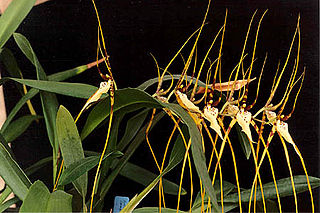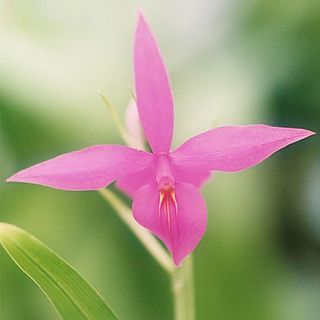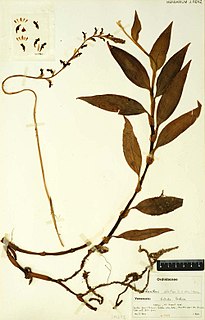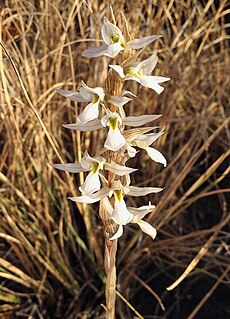
Phragmipedium is a genus of the Orchid family (Orchidaceae) and the only genus comprised in the tribe Phragmipedieae and subtribe Phragmipediinae. The name of the genus is derived from the Greek phragma, which means "division", and pedium, which means "slipper". It is abbreviated 'Phrag' in trade journals.

Stanhopea is a genus of the orchid family (Orchidaceae) from Central and South America. The abbreviation used in horticultural trade is Stan. The genus is named for the 4th Earl of Stanhope (1781-1855), president of the Medico-Botanical Society of London (1829-1837). It comprises 55 species and 5 natural hybrids. These epiphytic, but occasionally terrestrial orchids can be found in damp forests from Mexico to Trinidad to NW Argentina. Their ovate pseudobulbs carry from the top one long, plicate, elliptic leaf.

Brassia is a genus of orchids classified in the subtribe Oncidiinae. It is native to Mexico, Central America, the West Indies, and northern South America, with one species extending into Florida.

Chysis is a genus of orchids, consisting of 10 currently accepted species which originate in the region from Mexico to Peru. Only two or three of these are commonly found in cultivation. The genus is abbreviated Chy in trade journals.

Barkeria, abbreviated Bark in horticultural trade, is a genus of orchids. It consists of about 17 currently recognized species native to Mexico and Central America. This genus was once considered part of Epidendrum. Type species is Barkeria elegans; this is now considered a synonym of B. uniflora yet retains its status as type per ICN.

Barbosella is a genus of mostly creeping orchids. The genus has about 20 species, widespread across the West Indies and Latin America from Mexico and the Lesser Antilles to Argentina. Named after João Barbosa Rodrigues, an investigator of Brazilian orchids. They have solitary flowers with a unique lip base that works like a ball and socket.

Dryadella is a genus of miniature orchids, formerly included in the genus Masdevallia. Plants are typically composed of a tuft of leaves from 3 to 6 cm long. The small (1–2 cm) flowers are often conspicuously spotted, and are borne at the base of the leaves. There are about 40 species, distributed from southern Mexico to southern Brazil and northern Argentina. In cultivation many of the species seem to respond well to being grown on cork or treefern rather than in pots. The attractive species Dryadella edwallii, commonly known as 'Partridge in the Grass' can be easily grown into a spectacular specimen plant, full of flowers.

Kreodanthus is a small genus of orchids belonging to the subfamily Orchidoideae.

Ponthieva is a genus from the orchid family (Orchidaceae). They are named after Henry de Ponthieu, an English merchant of Huguenot ancestry who sent West Indian plant collections to Sir Joseph Banks in 1778.

Teuscheria is a genus of orchids native to southern Mexico, Central America and northern South America. The genus is named for Henry Teuscher, an award-winning landscape artist and horticulturalist.

Beloglottis is a genus of the family Orchidaceae. This genus belongs to the tribe Cranichideae and subtribe Spiranthinae. Orchids of the genus Beloglottis are terrestrial sympodial plants that can be used as herbal supplements. They have short, solitary stems that stand erect and the fleshy roots contain small hair-like projections and are arranged in a fascicle. Several leaves containing a petiole form at the base of the plant. The flowers appear as if they are upside down.

Arpophyllum is a genus of flowering plants from the orchid family, Orchidaceae. It contains 3 species, native to Mexico, Central America, Colombia, Venezuela and Jamaica.

Deiregyne is a genus of flowering plants from the orchid family, Orchidaceae, native to Mexico, Guatemala and Honduras.

Dichromanthus is a genus of flowering plants from the orchid family, Orchidaceae. As currently delimited, it is monophyletic and includes four species:
- Dichromanthus aurantiacus(Lex.) Salazar & Soto Arenas - much of Mexico, south to Honduras
- Dichromanthus cinnabarinus(Lex.) Garay - from Texas to Guatemala
- Dichromanthus michuacanus(Lex.) Salazar & Soto Arenas - from Texas and Arizona south to Honduras
- Dichromanthus yucundaaSalazar & García-Mend. - Oaxaca

Leochilus is a genus of flowering plants from the orchid family, Orchidaceae, native to Mexico, Central America, northern South America, the West Indies and Florida.
- Leochilus carinatus(Knowles & Westc.) Lindl. - Oaxaca, Veracruz
- Leochilus crocodiliceps(Rchb.f.) Kraenzl. in H.G.A.Engler - Jalisco, Colima
- Leochilus hagsateriM.W.Chase - Oaxaca
- Leochilus inconspicuus(Kraenzl.) M.W.Chase & N.H.Williams - Costa Rica
- Leochilus johnstoniiAmes & Correll - from Oaxaca south to Nicaragua
- Leochilus labiatus(Sw.) Kuntze - from Oaxaca south to Brazil; also West Indies and Florida
- Leochilus leiboldiiRchb.f. - Oaxaca, Veracruz
- Leochilus leochilinus(Rchb.f.) M.W.Chase & N.H.Williams - Nicaragua, Costa Rica, Panama
- Leochilus oncidioidesKnowles & Westc. - Mexico, Guatemala, Honduras
- Leochilus puertoricensisM.W.Chase - Puerto Rico, St. Lucia
- Leochilus scriptus(Scheidw.) Rchb.f. - from southern Mexico south to Ecuador; also Cuba, Trinidad, Dominican Republic
- Leochilus tricuspidatus(Rchb.f.) Kraenzl. in H.G.A.Engler - Costa Rica, Panama

Rhynchostele is a genus of flowering plants from the orchid family, Orchidaceae, native to Mexico, Central America and Venezuela. The genus name is abbreviated as Rst. in the horticultural trade.

Rossioglossum is a genus of flowering plants from the orchid family, Orchidaceae. It has 9 currently recognized species, all native to Mexico, Central America, and northern and western South America.
- Rossioglossum ampliatum(Lindl.) M.W.Chase & N.H.Williams - from Guatemala to Venezuela and Peru
- Rossioglossum grande(Lindl.) Garay & G.C.Kenn. - Chiapas, Guatemala, El Salvador, Costa Rica
- Rossioglossum hagsaterianumSoto Arenas - Nayarit, Jalisco
- Rossioglossum insleayi(Baker ex Lindl.) Garay & G.C.Kenn. - from Jalisco to Oaxaca
- Rossioglossum krameri(Rchb.f.) M.W.Chase & N.H.Williams - Nicaragua, Costa Rica, Panama
- Rossioglossum oerstedii(Rchb.f.) M.W.Chase & N.H.Williams - Costa Rica, Panama
- Rossioglossum schlieperianum(Rchb.f.) Garay & G.C.Kenn. - Guatemala, El Salvador, Costa Rica, Panama
- Rossioglossum splendens(Rchb.f.) Garay & G.C.Kenn. - Oaxaca
- Rossioglossum williamsianum(Rchb.f.) Garay & G.C.Kenn - Chiapas, Guatemala, Honduras

Sarcoglottis is a genus of flowering plants from the orchid family, Orchidaceae. It is widespread across much of Latin America from Mexico to Argentina, with one species extending northward into Trinidad and the Windward Islands.
Campylocentrum pachyrrhizum is a species of orchid. It is native to the West Indies, southern Mexico, Central America, northern South America, and southern Florida.
Stenotyla is a genus of orchids. It contains 9 known species, all native to Central America and southern Mexico.
- Stenotyla estrellensis(Ames) P.A.Harding - Costa Rica
- Stenotyla francoiArchila - Guatemala
- Stenotyla helleri(Fowlie) P.A.Harding - Nicaragua
- Stenotyla lankesteriana(Pupulin) Dressler - Costa Rica, Panama
- Stenotyla lendyana(Rchb.f.) Dressler - Oaxaca, Chiapas, Guatemala, El Salvador, Honduras
- Stenotyla maculataArchila - Guatemala
- Stenotyla maxillapertaArchila - Guatemala
- Stenotyla panamensisPupulin - Panama
- Stenotyla picta(Rchb.f.) Dressler - Costa Rica, Panama



















